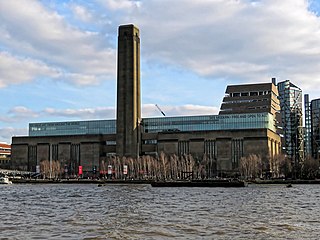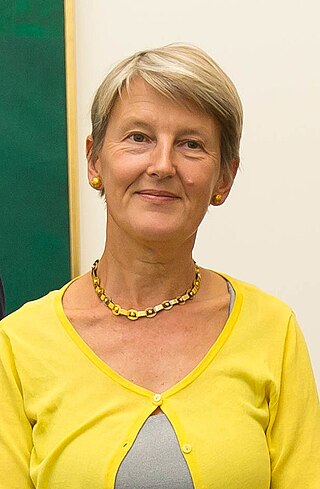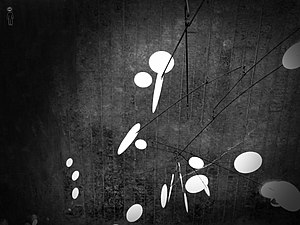
Tate Modern is an art gallery in London, housing the United Kingdom's national collection of international modern and contemporary art, defined as from after 1900, and forms part of the Tate group together with Tate Britain, Tate Liverpool and Tate St Ives. It is located in the former Bankside Power Station, in the Bankside area of the London Borough of Southwark.

Sir Richard Julian Long, is an English sculptor and one of the best-known British land artists.

Alexander Calder was an American sculptor known both for his innovative mobiles that embrace chance in their aesthetic, his static "stabiles", and his monumental public sculptures. Calder preferred not to analyze his work, saying, "Theories may be all very well for the artist himself, but they shouldn't be broadcast to other people."

The National Gallery of Art, and its attached Sculpture Garden, is a national art museum in Washington, D.C., United States, located on the National Mall, between 3rd and 9th Streets, at Constitution Avenue NW. Open to the public and free of charge, the museum was privately established in 1937 for the American people by a joint resolution of the United States Congress. Andrew W. Mellon donated a substantial art collection and funds for construction. The core collection includes major works of art donated by Paul Mellon, Ailsa Mellon Bruce, Lessing J. Rosenwald, Samuel Henry Kress, Rush Harrison Kress, Peter Arrell Browne Widener, Joseph E. Widener, and Chester Dale. The Gallery's collection of paintings, drawings, prints, photographs, sculpture, medals, and decorative arts traces the development of Western art from the Middle Ages to the present, including the only painting by Leonardo da Vinci in the Americas and the largest mobile created by Alexander Calder.

Mona Hatoum is a British-Palestinian multimedia and installation artist who lives in London.

Assemblage is an artistic form or medium usually created on a defined substrate that consists of three-dimensional elements projecting out of or from the substrate. It is similar to collage, a two-dimensional medium. It is part of the visual arts and it typically uses found objects, but is not limited to these materials.

Sam Durant is a multimedia artist whose works engage social, political, and cultural issues. Often referencing American history, his work explores culture and politics, engaging subjects such as the civil rights movement, southern rock music, and modernism.

Flamingo, created by noted American artist Alexander Calder, is a 53-foot-tall (16 m) stabile located in the Federal Plaza in front of the Kluczynski Federal Building in Chicago, Illinois, United States. It was commissioned by the United States General Services Administration and was unveiled in 1974, although Calder's signature on the sculpture indicates it was constructed in 1973.

Paul Matisse is an artist and inventor known for his public art installations, many of which are interactive and produce sound. Matisse also invented the Kalliroscope.

Maman (1999) is a bronze, stainless steel, and marble sculpture by the artist Louise Bourgeois. The sculpture, which depicts a spider, is among the world's largest, measuring over 30 ft high and over 33 ft wide (927 x 891 x 1024 cm). It includes a sac containing 32 marble eggs and its abdomen and thorax are made of rubbed bronze.

Tate Britain, known from 1897 to 1932 as the National Gallery of British Art and from 1932 to 2000 as the Tate Gallery, is an art museum on Millbank in the City of Westminster in London, England. It is part of the Tate network of galleries in England, with Tate Modern, Tate Liverpool and Tate St Ives. It is the oldest gallery in the network, having opened in 1897. It houses a substantial collection of the art of the United Kingdom since Tudor times, and in particular has large holdings of the works of J. M. W. Turner, who bequeathed all his own collection to the nation. It is one of the largest museums in the country. The museum had 525,144 visitors in 2021, an increase of 34 percent from 2020 but still well below pre- COVID-19 pandemic levels. In 2021 it ranked 50th on the list of most-visited art museums in the world.

The Hepworth Wakefield is an art museum in Wakefield, West Yorkshire, England, which opened on 21 May 2011. The gallery is situated on the south side of the River Calder and takes its name from artist and sculptor Barbara Hepworth who was born and educated in the city. It is the successor of the municipal art collection, founded in 1923 as Wakefield Art Gallery, which spans the Old Masters to the twentieth century.
Lobster Trap and Fish Tail, a mobile by American artist Alexander Calder, is located at the Museum of Modern Art in New York City, New York, United States. It is one of Calder's earliest hanging mobiles and "the first to reveal the basic characteristics of the genre that launched his enormous international reputation and popularity."
The year 2012 in art involves some significant events.

Modern sculpture is generally considered to have begun with the work of Auguste Rodin, who is seen as the progenitor of modern sculpture. While Rodin did not set out to rebel against the past, he created a new way of building his works. He "dissolved the hard outline of contemporary Neo-Greek academicism, and thereby created a vital synthesis of opacity and transparency, volume and void". Along with a few other artists in the late 19th century who experimented with new artistic visions in sculpture like Edgar Degas and Paul Gauguin, Rodin invented a radical new approach in the creation of sculpture. Modern sculpture, along with all modern art, "arose as part of Western society's attempt to come to terms with the urban, industrial and secular society that emerged during the nineteenth century".

The original Decor for Satie's "Socrate" was designed by mobile artist Alexander Calder for a touring performance of Erik Satie’s symphonic drama Socrate in 1936. It was a mobile set considered by Virgil Thomson as one of the masterpieces of twentieth-century theatre design. It consisted of three elements: a red disc, interlocking steel hoops, and a vertical rectangle, black on one side and white on the other, against a blue backdrop. Destroyed in a fire in 1936, the decor was recreated by Walter Hatke in 1976 for a performance in New York.

Bent Propeller was a red stainless steel sculpture by Alexander Calder.

Penelope Curtis is a British art historian and curator. Fom 2015 to 2020 she was the director of Lisbon's Museu Calouste Gulbenkian, and from 2010 to 2015 director of Tate Britain. She is the author of several monographs on sculpture and has written widely at the invitation of contemporary artists.

Recumbent Figure 1938 (LH191) is an early sculpture by Henry Moore. It was commissioned by the architect Serge Chermayeff for his modernist villa at Bentley Wood, near Halland, Sussex. At the time it was made, it was Moore's largest stone sculpture. It was donated to the Tate Gallery in 1939, making it the first example of Moore's work in a public collection.




















